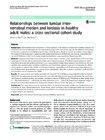| dc.contributor.author | du Rose, Alister | |
| dc.contributor.author | Breen, Alan | |
| dc.date.accessioned | 2018-06-20T10:37:50Z | |
| dc.date.available | 2018-06-20T10:37:50Z | |
| dc.date.issued | 2016 | |
| dc.identifier.citation | du Rose, A. and Breen, A., 2016. Relationships between lumbar inter-vertebral motion and lordosis in healthy adult males: a cross sectional cohort study. BMC Musculoskeletal Disorders, 17:121 https://doi.org/10.1186/s12891-016-0975-1 | en |
| dc.identifier.issn | 1471-2474 | |
| dc.identifier.uri | https://aecc.archive.knowledgearc.net/handle/123456789/16 | |
| dc.description | Available under License - Creative Commons Attribution: https://creativecommons.org/licenses/by/4.0/ | en |
| dc.description.abstract | Background: Intervertebral motion impairment is widely thought to be related to chronic back disability, however, the movements of inter-vertebral pairs are not independent of each other and motion may also be related to morphology. Furthermore, maximum intervertebral range of motion (IV-RoMmax) is difficult to measure accurately in living subjects. The purpose of this study was to explore possible relationships between (IV-RoMmax) and lordosis, initial attainment rate and IV-RoMmax at other levels during weight-bearing flexion using quantitative fluoroscopy (QF).
Methods: Continuous QF motion sequences were recorded during controlled active sagittal flexion of 60° in 18 males (mean age 27.6 SD 4.4) with no history of low back pain in the previous year. IV-RoMmax, lordotic angle, and initial attainment rate at all inter-vertebral levels from L2-S1 were extracted. Relationships between IV-RoMmax and the other variables were explored using correlation coefficients, and simple linear regression was used to determine the effects of any significant relationships. Within and between observer repeatability of IV-RoMmax and initial attainment rate measurements were assessed in a sub-set of ten participants, using the intra-class correlation coefficient (ICC) and standard error of measurement (SEM).
Results: QF measurements were highly repeatable, the lowest ICC for IV-RoMmax, being 0.94 (0.80–0.99) and highest SEM (0.76°). For initial attainment rate the lowest ICC was 0.84 (0.49–0.96) and the highest SEM (0.036). The results also demonstrated significant positive and negative correlations between IV-RoMmax and IV-RoMmax at other lumbar levels (r = −0.64–0.65), lordosis (r = −0.52–0.54), and initial attainment rate (r = −0.64–0.73). Simple linear regression analysis of all significant relationships showed that these predict between 28 and 42 % of the variance in IV-RoMmax.
Conclusions: This study found weak to moderate effects of individual kinematic variables and lumbar lordosis on IV-RoMmax at other intervertebral levels. These effects, when combined, may be important when such levels are being considered by healthcare professionals as potential sources of pain generation. Multivariate investigations in larger samples are warranted. | en |
| dc.language.iso | en | en |
| dc.publisher | BMC Musculoskeletal Disorders | en |
| dc.subject | Fluoroscopy | en |
| dc.subject | Lordosis | en |
| dc.title | Relationships between lumbar inter-vertebral motion and lordosis in healthy adult males: a cross sectional cohort study | en |
| dc.type | Article | en |
| dc.identifier.doi | https://doi.org/10.1186/s12891-016-0975-1 | |
